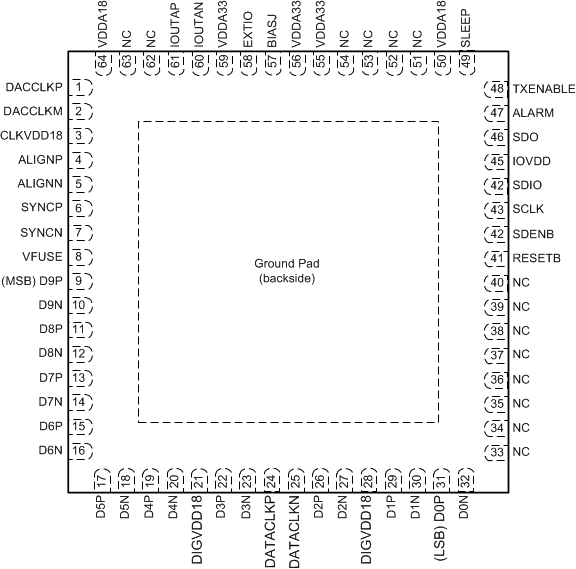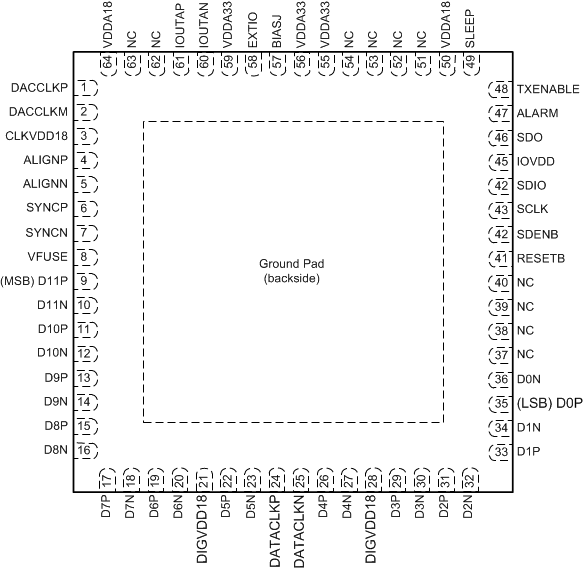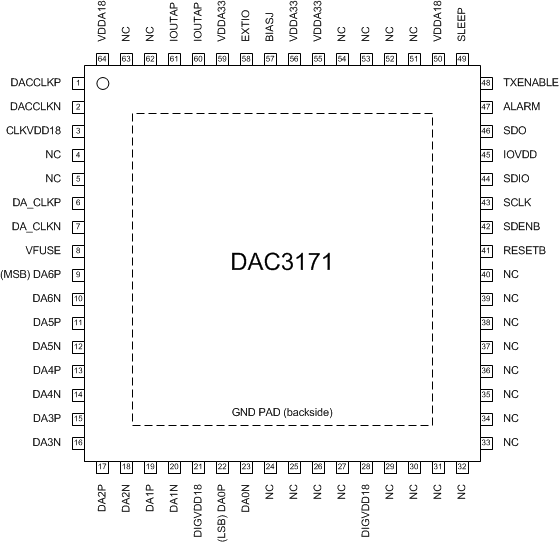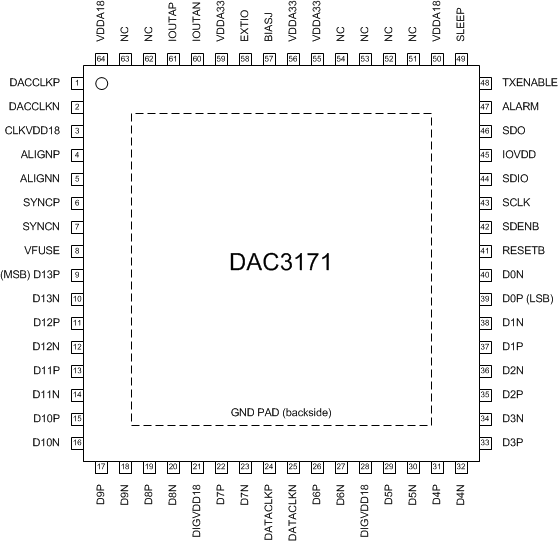SLAS959D August 2013 – February 2018 DAC3151 , DAC3161 , DAC3171
PRODUCTION DATA.
- 1 Features
- 2 Applications
- 3 Description
- 4 Revision History
- 5 Pin Configuration and Functions
-
6 Specifications
- 6.1 Absolute Maximum Ratings
- 6.2 ESD Ratings
- 6.3 Recommended Operating Conditions
- 6.4 Thermal Information
- 6.5 Electrical Characteristics: DC Specifications
- 6.6 Electrical Characteristics: AC Specifications
- 6.7 Electrical Characteristics: Digital Specifications
- 6.8 Timing Requirements
- 6.9 Typical Characteristics
-
7 Detailed Description
- 7.1 Overview
- 7.2 Functional Block Diagrams
- 7.3 Feature Description
- 7.4 Device Functional Modes
- 7.5 Programming
- 7.6
Register Map
- 7.6.1 Register Name: config0 – Address: 0x00, Default: 0x4FC
- 7.6.2 Register Name: config1 – Address: 0x01, Default: 0x600E
- 7.6.3 Register Name: config2 – Address: 0x02, Default: 0x3FFF
- 7.6.4 Register Name: config3 – Address: 0x03, Default: 0x0000
- 7.6.5 Register Name: config4 – Address: 0x04, Default: 0x0000
- 7.6.6 Register Name: config5 – Address: 0x05, Default: 0x0000
- 7.6.7 Register Name: config6 – Address: 0x06, Default: 0x0010(DAC3171); 0x0094(DAC3161); 0x0098(DAC3151)
- 7.6.8 Register Name: config7 – Address: 0x07, Default: 0xFFFF
- 7.6.9 Register Name: config8 – Address: 0x08, Default: 0x6000
- 7.6.10 Register Name: config9 – Address: 0x09, Default: 0x8000
- 7.6.11 Register name: config10 – Address: 0x0A, Default: 0xF080
- 7.6.12 Register Name: config11 – Address: 0x0B, Default: 0x1111
- 7.6.13 Register Name: config12 – Address: 0x0C, Default: 0x3A7A
- 7.6.14 Register Name: config13 – Address: 0x0D, Default: 0x36B6
- 7.6.15 Register Name: config14 – Address: 0x0E, Default: 0x2AEA
- 7.6.16 Register name: config15 – Address: 0x0F, Default: 0x0545
- 7.6.17 Register Name: config16 – Address: 0x10, Default: 0x0585
- 7.6.18 Register Name: config17 – Address: 0x11, Default: 0x0949
- 7.6.19 Register Name: config18 – Address: 0x12, Default: 0x1515
- 7.6.20 Register Name: config19 – Address: 0x13, Default: 0x3ABA
- 7.6.21 Register Name: config20– Address: 0x14, Default: 0x0000
- 7.6.22 Register Name: config21– Address: 0x15, Default: 0xFFFF
- 7.6.23 Register Name: config22– Address: 0x16, Default: 0x0000
- 7.6.24 Register Name: config23– Address: 0x17, Default: 0x0000
- 7.6.25 Register Name: config24– Address: 0x18, Default: 0x0000
- 7.6.26 Register Name: config25– Address: 0x19, Default: 0x0000
- 7.6.27 Register Name: config127– Address: 0x7F, Default: 0x0045
- 8 Application and Implementation
- 9 Power Supply Recommendations
- 10Layout
- 11Device and Documentation Support
- 12Mechanical, Packaging, and Orderable Information
Package Options
Mechanical Data (Package|Pins)
- RGC|64
Thermal pad, mechanical data (Package|Pins)
- RGC|64
Orderable Information
5 Pin Configuration and Functions
RGC Package
64-Pin VQFN
Top View

Pin Functions: DAC3151
RGC Package
64-Pin VQFN
Top View

Pin Functions: DAC3161
RGC Package
64-Pin VQFN
Top View

Pin Functions: DAC3171 7-Bit Interface Mode
RGC Package
64-Pin VQFN
Top View
